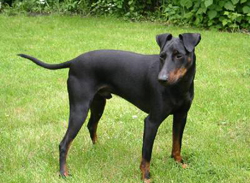The Manchester Terrier comes in two sizes: the Toy, weighing up to 12 pounds, and the Standard, which weighs between 12 and 22 pounds. Both varieties have sleek, short coats that are colored black and tan with a small tan marking over each eye and on each cheek. Manchester Terriers have wedge-shaped heads, tapered tails, and very dark, almond-shaped eyes.
Exposure to different smells, sights, sounds, animals, and people is crucial. Later in life, walks around town on a leash and frequent visits to neighbor's homes and local businesses are beneficial.
Well-mannered, intelligent, and lively dogs, Manchester Terriers do well in both urban and rural environments. They get along very well with other animals, including dogs, and make great family companions. These dogs require a daily walk and a lot of attention, which may make them unsuitable for very busy families.
Other than size, the only difference between the Standard and Toy breeds is the shape of their ears. The Standard's ears can be naturally erect, cropped, or button ears. The Toy's ears are always naturally erect.
Lively and sharp witted, but with a steady temperament and high degree of patience, Manchester Terriers make excellent family pets. These dogs get along great with children and other animals, and they are generally well behaved. They do crave a lot of attention and affection, however, and may become lonely or bored in homes where they don't have frequent interaction with their human family members.
These dogs are very devoted and loyal to their family members and form strong bonds early in life. They are also sensitive and responsive and are known for being catlike due to their independence and tendency to self-groom. Manchester Terriers love napping with their family, playing games, and just hanging out around the house.
Manchester Terriers need a long walk on a leash every day, and they will also benefit from frequent romps in the yard, provided it is securely fenced. Dogs living in rural areas will love the occasional run through an open field. Without adequate physical activity, these dogs are at risk for behavioral problems and weight gain.
Manchester Terriers are known to suffer from several health conditions that can shorten their lifespan or interfere with mobility or quality of life. Common health issues in the breed include hip dysplasia, patellar luxation, and eye conditions such as cataracts, lens luxation, and glaucoma. These dogs are also sometimes affected by a bleeding disorder called von Willebrand's disease. This disease is inherited.
Other health problems in the breed include epilepsy, hypothyroidism, and skin fragility. Toy Manchesters are also prone to a condition called Legg-Calve-Perthes disease, a condition characterized by the spontaneous degeneration of the femur head. Symptoms include lameness, pain, and wasting of the thigh muscles on the affected leg. Treatments are available to help manage the condition.
With routine veterinary care, regular vaccinations, a well-balanced diet, and daily exercise, Manchester Terriers can live up to 16 years.
Manchester Terriers are eager to learn and highly intelligent, but they also tend to be stubborn and have a tendency to test boundaries. Training must be very consistent if there is to be any chance of success. Positive reinforcement techniques, including food, praise, and play rewards, work well with this breed.
Digging and barking can become problematic in this breed unless these behaviors are specifically addressed during training. Manchester Terriers make good watchdogs, but they may get carried away with their duties. Also, while they are not as aggressive as some other terrier breeds, Manchester Terriers can't resist chasing rodents and other small animals.
To ensure these dogs grow into tolerant adults, socialization must begin very early in life and continue throughout adulthood. Exposure to different smells, sights, sounds, animals, and people is crucial. Later in life, walks around town on a leash and frequent visits to neighbor's homes and local businesses are beneficial.
Manchester Terriers are very neat dogs that generally groom themselves. Their glossy coat sheds little and only requires occasional brushing. A natural bristle brush is the best choice for grooming these dogs, and application of a coat conditioner or polish will brighten the coat and improve its appearance.
Although these dogs rarely need bathing and have very little dog odor, a bath every few months is a good idea for the health of their skin and coat. A mild, pH-balanced canine shampoo will prevent skin irritation and leave the coat shiny and manageable. Bathing is also important should the Manchester Terrier decide to roll around in something harmful, stinky, or sticky.
The nails need trimming every two to three weeks, and the teeth should be brushed daily with a veterinarian-approved canine toothpaste to protect tooth and gum health. Dental chews will help ensure oral health and will keep the breath smelling nice. The ears must be checked at least once weekly for signs of infection, such as redness, bad odor, or discharge, and any excess ear wax should be removed with a canine otic cleanser.
Manchester Terriers originated in Manchester, England during the 19th century. The breed was developed from crossing a Whippet and a rat-catching terrier. These dogs were primarily used to chase rats and other vermin from warehouses, stables, and barns. They excelled in this role and were beloved for their natural abilities.
Later in the 19th century, demand for a smaller Manchester Terrier started to increase. It was then that breeders began experimenting and the toy breed was developed. The Toy and Standard were registered as separate breeds until 1959, when they became one breed with two varieties.
In the United States, these dogs are primarily kept as companion animals, although the breed retains its rat-hunting abilities and is sometimes used in rural areas for this purpose.
The American Kennel Club officially recognized the Manchester Terrier Toy in 1886 and the Manchester Terrier Standard in 1887.

